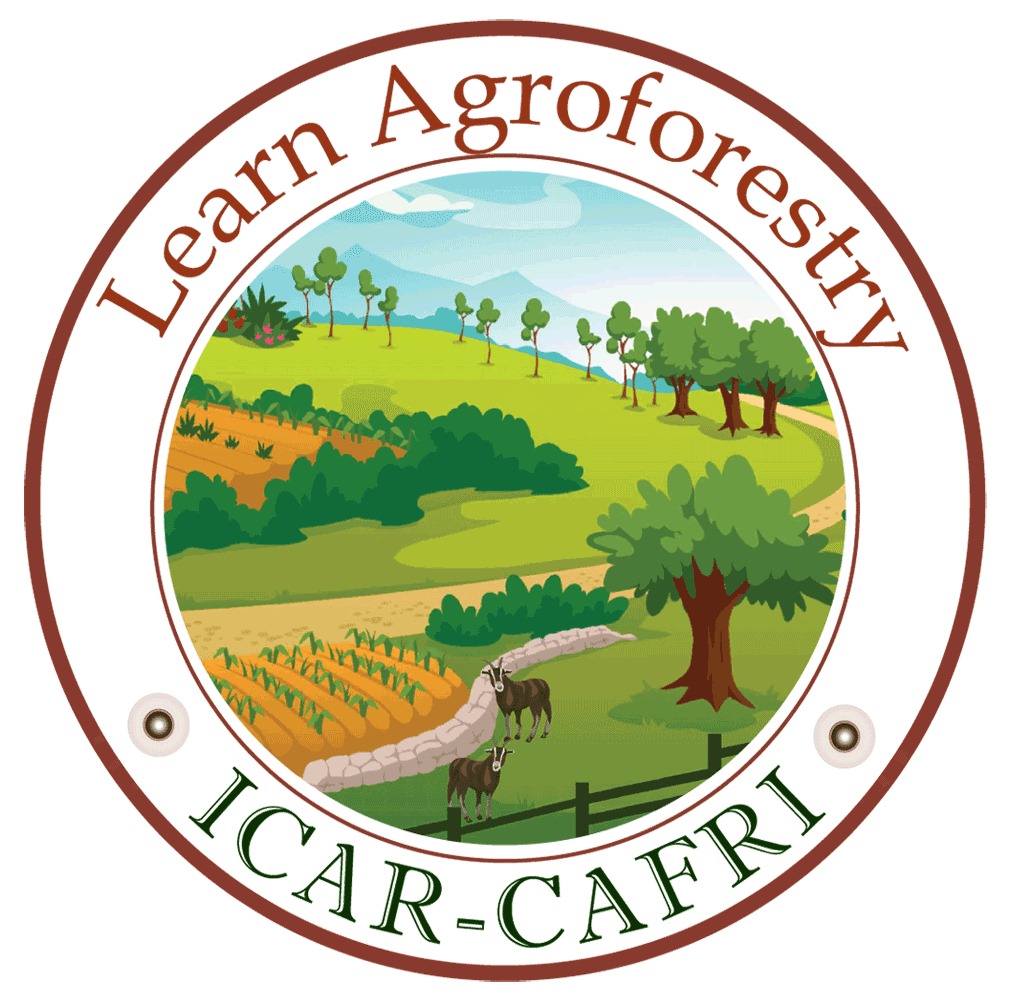Neem Field Gene Bank at Central Agroforestry Research Institute, Jhansi
Overview
The ICAR-Central Agroforestry Research Institute (CAFRI), Jhansi, Uttar Pradesh serves as a National Repository of Neem germplasm. Initially, 276 accessions was assembled at the institute Field Gene Bank from Maharashtra, Andhra Pradesh, Rajasthan, Uttar Pradesh, Madhya Pradesh, Orissa, Haryana, Karnataka and Tamil Nadu through extensive exploration, collection and/or as gifts from some participating institutes/universities in the All India Coordinated Research Project (AICRP) on Agroforestry. Mainly, these accessions were collected from farmer’s field. To date, 170 accessions are in our field gene bank. Among these accessions 139 were registered as indigenous collection (IC) with National Bureau of Plant Genetic Resource (NBPGR), New Delhi. These collection serves as a wide gene pool for various economic seed associated traits including oil and azadirachtin content yield improvement. The conserved germplasm has been characterized for important morpho-agronomic traits of neem. Due to short-term viability limited volume of seed collection done in every year become a source for further distribution and utilization. Neem germplasm conserved at CAFRI field gene bank has become an important source of diversity. These materials shall be made available to researchers in both public and private sectors across the world through germplasm exchange guidelines. The collections held at the field gene bank are also serving the purpose of restoration of germplasm to the source origin states when native collections are lost due to natural calamities, civil strife, etc. This field gene bank has promoted testing and release of accessions directly as superior varieties in location for different agro-ecological region in India.
Common Name
Neem
Botanical Name
Azadirachta indica
Family
Meliaceae
Potential Area
A. indica is grown from the southern tip of Kerala. Himalayan hills in the tropical to sub-tropical and semi-arid to wet tropical regions. In India, it occurs throughout the larger parts of the country in the states of Uttar Pradesh, Bihar, West Bengal, Orissa, Delhi, Maharashtra, Gujarat, Andhra Pradesh, and Tamil Nadu and in tropical dry deciduous and thorny forests and in the drier parts up to 1500 m.

Silvicultural Requirement
The Neem tree is noted for its drought resistance. Normally it thrives in areas with sub-arid to sub-humid conditions with an annual rainfall between 400 mm and 1200 mm. Neem is susceptible to low temperature and waterlogging. It grows well on a wide variety of deep or shallow soils ranging from sandy soils in Rajasthan to clayey soils in Maharashtra.. Its best growth is reported from black cotton soils. It can also come up on soil, where there is hard calcareous or clay pan just below the soil surface. The soil pH needed for the optimum growth is 6.2 and above.
Nursery Techniques
By Seed-Only fruits at the yellow-green colour stage are pricked from the branches. To ensure a higher germination rate, immediate sowing of seeds in nursery is recommended. Seeds are sown 2.5 cm deep at of 2 to 5 cm distance in lines and lightly covered with earth to safeguard against birds and insects which often eat up radicles of the germinated seeds. Alternatively, seeds can be sown directly into pots. Germination occurs within 10-15 days. Seeds are sown three or four months before the scheduled planting date. Potting mix comprises 50% sandy loam, 40% river sand and 10% compost by volume. If polythene bags are used for transplanting, they should be filled with silt, sand, clay and farmyard manure in the ratio of 1:1:1:1.
By Vegetative
About 1-2 cm diameter hardwood cuttings are collected and terminal portion of leaves is excised and branches are made into 15-20 cm long cuttings. A 1000 ppm of IBA treatment is given as basal dip. Then the cuttings are planted in nursery beds under 50-60% shade. The per cent of rooting is low.

Planting Techniques
The field should be properly ploughed. The seedlings of 4 to 6 months old (15 to 22.5 cm height) are should be selected planting.
Pits of dimension 30 cm × 30 cm × 30 cm should be dug at a distance of 5 m × 5 m (400 plants per hectare.). After they have established well, they may be watered once in 7 to 10 days.
Tending Operation
Weeding
Two to three weedings in the first year and one in the second year are recommended for plantations raised by seedlings.The second weeding and hoeing should be done in the month of October, and plants may be irrigated as required.
Manure & Fertilizer
About 5-6 kg green manure, 20-25 g Edosulphan dust, 10 g Urea, 20 g Single Super Phosphate, 20 g MOP (Muriate of Potash), 1-2 kg cake of Neem per plant may be used during transplantation and the following 2 years. For protection against harmful insects, 0.25% Malathion or 0.02% Democron should be sprayed.
Pruning
Based on objective of end product pruning practice is decided. If tree are grown for timber purposes, trees requires pruning at-least once in two-three years to get knot free timber.
Thinning
The first mechanical thinning is usually done when the crop completes the age of 3-4 years. A second thinning may be necessary at the age of 6 years. Thinning schedule can be worked out depending upon the site quality and plant growth.



Suitable Agroforestry Models
Neem has been found to be quite suitable as an agroforestry tree species with good economic value. In semi-arid conditions at the IGFRI, Jhansi, neem along with other tree species increased the productivity of a silvi-cultural system by up to 8.5 t/ha. It has been reported that the fodder production can be increased from 0.5 t/ha to 3.6 t/ha in the arid zone of Thar Desert by growing suitable grasses and legumes along with Neem and other tree species. The short-duration and dwarf annual oilseed as well as pulse (leguminous) crops like groundnut, mustard, chickpea, cowpea, horse gram and soybean can be grown successfully as inter-crops for up to 4-5 years in Neem plantations. This helps generate additional income as well as facilitates maintenance of plantation during the initial 4- 5 yearsTree Protection
Tip borer (Laspeyresia koenigiana) and tea mosquito bug (Heliopeltis antonii) attack seedlings and young plants. Pulvinaris maxima is a scale insect now regarded as a key pest and Heliothrips haemorrhoidalis a potential pest of Neem. Seedlings also get severely affected by damping-off, Rhizoctonia leaf web blight, leaf spot and blights induced by Colletotrichum sp., Alternaria sp.and Pseudocercospora sp.Yield
Neem bears an ovoid fruit, 2 cm × 1 cm that has a pericarp containing a resinous substance with a garlicky odour. Each seed contains one kernel. The seed kernels, which weigh 0.2 g, constitute some 50-60% of the seed weight and 25% of the fruit. The fat content of the kernels ranges from 30 to 50%. The tree starts bearing fruit after 3-5 years and comes to full bearing at the age of 10-12 years. Fruit yield is 10-25 kg per tree per year in the initial years. A mature tree produces 30-100 kg fruit per year. It has been estimated that a 10-year-old tree can yield 5-6 cu ft of timber.Utility
Neem tree provides twigs for brushing teeth, pharmaceuticals for aches and pains and pest control. It is drought tolerant and helps to reduce soil erosion. It is used to produce soap, lamp oil, lubricant and lumber. It is also a good shade tree. Wood is used for making furniture, cart axles, cabinets, packing cases, ornamental cuttings, ship and boat building, helms, oars, cigar boxes, carved images, toys, drums and agricultural implements. The leaves are palatable to cattle and buffaloes and constitute a traditional feed in several parts of the countryUtility
- Babul yields several products, including timber, firewood, bark gum and fodder leaves. Timber is used for construction, agricultural implements, and sports and athletic goods.
- The wood makes excellent fuel, and the calorific value of heartwood is 4946 kcal/kg. The wood yields a high grade charcoal.
- The bark and pods of the tree is used for tanning by local tanneries.
- The tree yields a black gum known as Amravati gum or Indian gum Arabic which is used for matches, ink paints, calico-printing etc.







